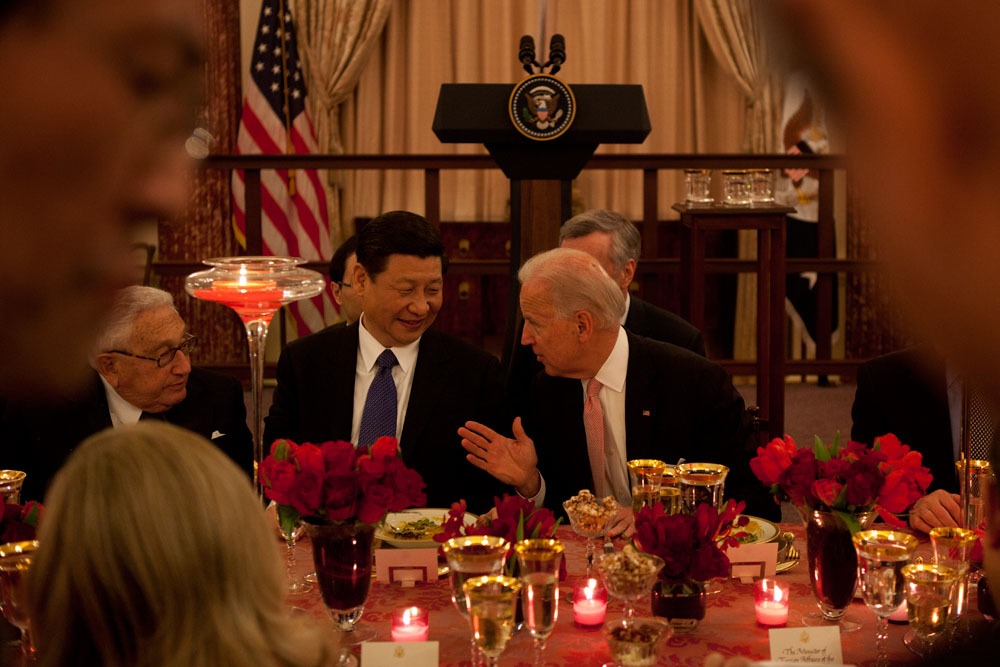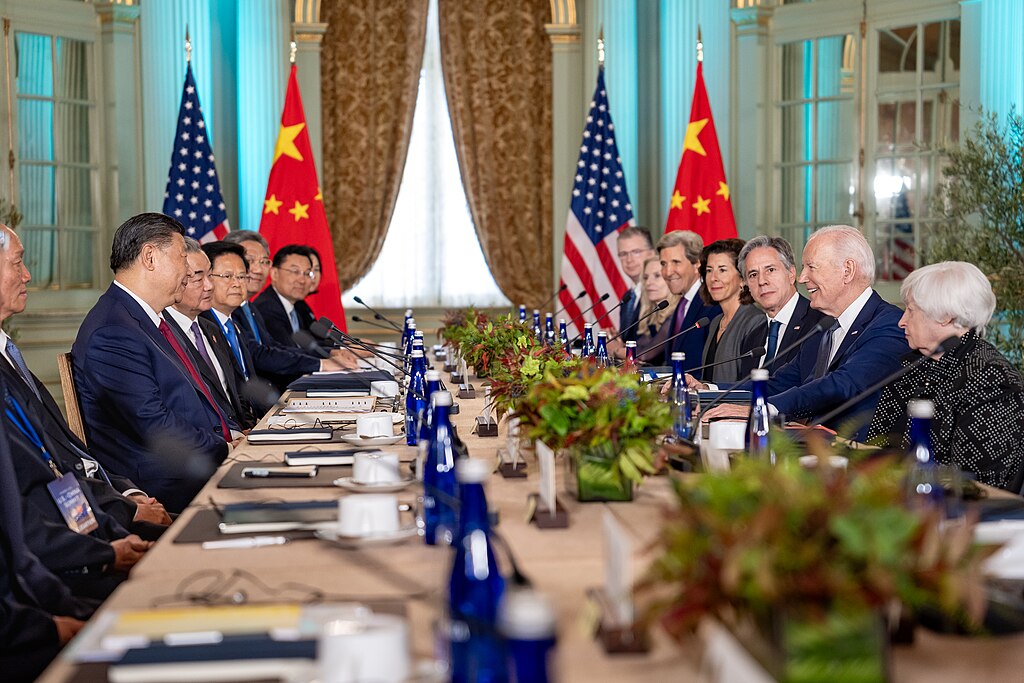It’s Time to Talk About No First Use
FOREIGN POLICY
APLN member Tong Zhao argues that exploring credible No First Use models can lead to more substantive nuclear arms control and strategic risk reduction talks. The original article can be found on the Foreign Policy website here.
Long a nonstarter in Washington, it may now be the best source of common ground with Beijing.
On Monday, the Biden administration is holding talks with China on nuclear arms control, a rare departure from their otherwise tense relationship, ahead of the anticipated November summit between U.S. President Joe Biden and Chinese President Xi Jinping. The talks—the first of their kind since the Obama administration—will broadly cover arms control and nonproliferation, but could also include crisis communications as well as nuclear doctrine, policy, and spending, as reported by the Wall Street Journal.
The talks come at a time of heightened nuclear tensions—not only amid Russia’s saber-rattling in Ukraine, but also as China rapidly expands its nuclear capabilities, and the United States feels immense pressure to enhance its own arsenal. If trends continue, this buildup could potentially overturn the decadeslong trend of U.S. nuclear reduction and further exacerbate the unprecedented regional arms racing in the Asia-Pacific.
Beijing maintains that the policy of no first use of nuclear weapons (NFU), which China has long endorsed, should be the foremost topic for any discussion on nuclear weapons. In August, China’s Ministry of Foreign Affairs doubled down on this insistence. However, such a prerequisite would mark a significant divergence from U.S. declaratory policy and has thus been a nonstarter for Washington.
But the United States’ assumption that discussing nuclear issues with China requires it to be open to adopting a categorical NFU policy is mistaken. There is indeed an opening to start dialogue with China on substantive and mutually beneficial issues, all without requiring Washington to commit to significantly altering its existing nuclear policy.
For decades, China has maintained a unilateral policy of NFU, in which Beijing pledges not to use nuclear weapons first under any conditions. But in the United States, NFU has been caught up in its own tangled history of domestic debates. Since the Cold War, U.S. decision-makers have frequently believed that maintaining a policy of “calculated ambiguity” provides a more robust deterrent than an unequivocal rejection of first use. Concerns have also arisen about whether conventional weapons alone can effectively deter adversaries from launching chemical, biological, and other nonnuclear strategic attacks.
In recent years, both Presidents Barack Obama and Joe Biden have exhibited interest in NFU, but they faced opposition from certain U.S. allies. Japan, for instance, worries that an unconditional U.S. NFU commitment might embolden China’s conventional military aggression or undermine Washington’s commitment to employ nuclear weapons in defense of its allies against existential threats.
Here, as with elsewhere in the U.S.-China relationship, fear and suspicion are pervasive. Whatever each country feels about the credibility and consequences of their own assurances, it’s clear that they both harbor mistrust about other side’s sincerity. Many in Washington contend that China’s NFU policy can be deceptive. U.S. nuclear strategists have drawn parallels to the Soviet policies of the 1980s, when military planners secretly included first-use options in their contingency plans despite political leadership publicly endorsing NFU. For such reasons, in 2020, then-commander of the U.S. Strategic Command Adm. Charles Richard claimed that he “could drive a truck through” China’s NFU policy. U.S. skepticism has only grown as Beijing expands and diversifies its nuclear arsenal. This, along with the introduction of precision regional-range nuclear weapons and an emphasis on rapid launch capabilities, has heightened Washington’s concerns that Beijing may be contemplating the first use of nuclear weapons against regional military targets—directly contradicting its NFU pledge.
China shares strikingly similar concerns. When Biden advocated for reducing the role of nuclear weapons in U.S. foreign policy during his presidential campaign, Chinese experts raised questions about the substantive value and reliability of a potential U.S. NFU declaration.
Growing Chinese suspicion of U.S. strategic intentions in recent years has often led to the misinterpretation of specific U.S. policies. Though the U.S. posture primarily focuses on deterring the first use of nuclear weapons by adversaries, Beijing suspects that Washington may be increasingly inclined to issue nuclear threats in the event of future conflicts due to diminishing U.S. conventional military superiority in the region. The renewed U.S. emphasis on low-yield tactical nuclear weapons has further fueled China’s apprehension that Washington intends to make its nuclear weapons more usable.
Whether or not these assessments are true, the mere fear that the other side might use nuclear weapons first may trigger worst-case reactions during crises. This fear also generates significant pressure to engage in nuclear arms racing during peacetime, further undermining the already tense bilateral relationship.
Monday’s initial meeting—though likely to be a general discussion without much substantive exploration of forward-looking measures—is a much-needed first step for both parties to better understand each other and their respective nuclear postures. To this end, although NFU has proved thorny in the past, discussing it in the current context is one of best ways available to reduce the risks of mutual misperception and catastrophic escalation.
First and foremost, Washington and Beijing need a shared understanding of what defines a credible NFU commitment. Government-affiliated experts from both countries should take part in comprehensive discussions to develop a common set of criteria for assessing whether a nation’s nuclear force structure, technological capabilities, operational postures, and military doctrines align with an NFU commitment. This is a vital prerequisite for any potential formal negotiations on the topic and should be seriously addressed in a U.S-China nuclear dialogue. With China’s growing nuclear forces, ensuring consistency between declaratory and operational policies is no longer primarily a U.S. responsibility.
The security concerns of U.S. allies in East Asia will continue to pose a significant hurdle for Washington in embracing NFU, so long as they feel threatened by China’s conventional military actions. If China hopes to sway the United States in this area, it stands to benefit from a better understanding of how its own behavior affects the conventional security concerns of U.S. allies.
Thus, another valuable topic for a U.S.-China nuclear dialogue to address is the interplay between conventional and nuclear issues within the NFU context. Given the pace of its conventional buildup, Beijing has yet to fully appreciate the threat perceptions that have developed among its neighbors. U.S. representatives could offer in-depth briefings to their Chinese counterparts on Washington’s endeavors to comprehend and mitigate allies’ concerns about the potential adverse impacts of NFU on their conventional military security.
These discussions would not require any policy change, but with an improved foundation of understanding, the United States and China could delve deeper into potential cooperative measures.
One such measure would involve only minor policy adjustments but could significantly enhance security for all parties involved: a situation-specific NFU agreement for a Taiwan contingency, where the risk of military conflict is most pronounced. Reaching such an agreement would be the best option for both parties to prevent tensions from spiraling out of control at a relatively low geopolitical cost.
Despite both sides’ assurances to the contrary, the United States and China both increasingly suspect the other of planning to start trouble over Taiwan. A political agreement renouncing the first use of nuclear weapons in or around the island, or against each other’s territories, facilities, and forces in a Taiwan contingency, would lower the risk of misinterpretation and potentially dangerous escalation.
For the United States, a Taiwan-specific NFU agreement would make it more costly for China to employ nuclear coercion against Taiwanese and U.S. forces. And while categorical NFU declarations have worried East Asian U.S. allies such as South Korea and Japan, a bilateral NFU agreement limited to a Taiwan contingency would not impact existing U.S. security commitments and would maintain the broader U.S. nuclear posture in military contingencies beyond Taiwan. In fact, it could enhance the security of these very allies by reducing the risk of nuclear use in their vicinity.
In the absence of an existential threat from China, it is unquestionably in the best interest of Washington and its allies to confine any conflict with China to conventional levels. And while a conventional military conflict over Taiwan might drag in some U.S. allies, it is unlikely to result in a full-scale Chinese invasion against them.
In such circumstances, U.S. allies should have every interest in avoiding nuclear use in their backyards. Further, by managing the risk of nuclear escalation, Washington and its allies could more effectively collaborate on strengthening their conventional deterrence, a factor that holds greater sway than nuclear weaponry in shaping the outcome of future conflicts.
For China, a Taiwan-specific agreement would enhance the credibility and deterrent effect of its own NFU policy. Discussing the topic with the United States would allow Beijing to explicitly address perceived loopholes in its traditional NFU declaration regarding whether this policy applies to its claimed territories, including Taiwan. This clarification aligns with Beijing’s interests, as it diminishes Taiwan’s need to request an extension of Washington’s nuclear umbrella to cover Taiwan—a matter reportedly raised by Taiwan’s foreign minister with Washington earlier this year.
Plus, compared with other cooperative risk-reduction measures, an NFU agreement would not legitimize U.S. close-range military reconnaissance activities near China, which is a significant concern for China and has hindered its willingness to engage in risk reduction discussions with Washington thus far.
By establishing a clearer red line and raising the reputational costs for issuing nuclear threats, such an agreement would help both countries deter the use of nuclear coercion for broader security and political objectives—a growing international concern in the aftermath of Russia’s manipulation of nuclear risks in the Ukraine war.
Though it may seem like a long shot, it is crucial that Washington and the international community not disregard the importance of discussing NFU with China. Taking an open-minded approach to discussing it would, at the very least, allow Washington to assess the credibility of China’s repeated proposition that progress on the NFU issue is crucial for initiating serious discussions on nuclear weapons-related matters.
Instead of engaging in formal negotiations over the U.S. adoption of an NFU policy, participating in an open-ended discussion aimed at developing mutual understandings of credible NFU models would not contradict any existing U.S. policy. Such discussion could also establish a foundation for more ambitious cooperative measures. It thus offers the best prospect for commencing much-needed dialogues with China on strategic risk reduction, which is in the keen interests of both nations—and the rest of the world.
Image: A man visits an exhibition center located in the retired atom bomb base at the Jinyintan Grassland in the town of Xihai in the Tibet Autonomous Region on Oct. 19, 2006. CHINA PHOTOS/GETTY IMAGES



